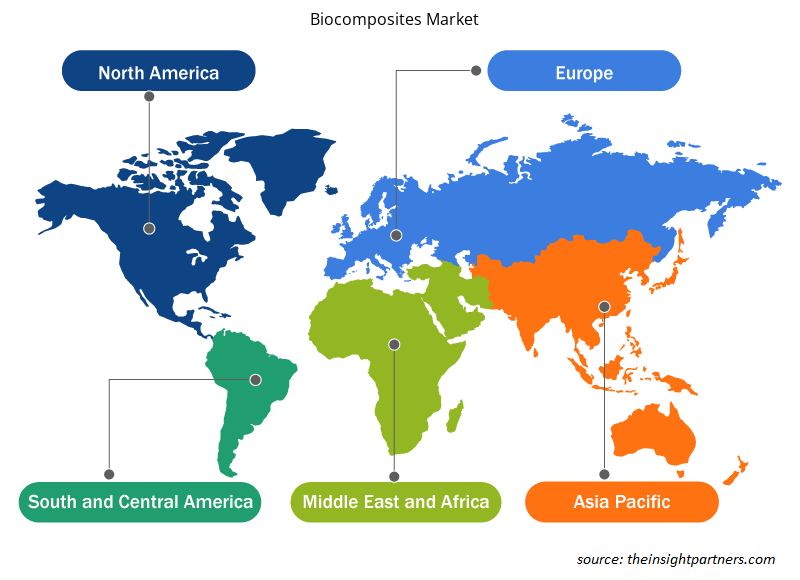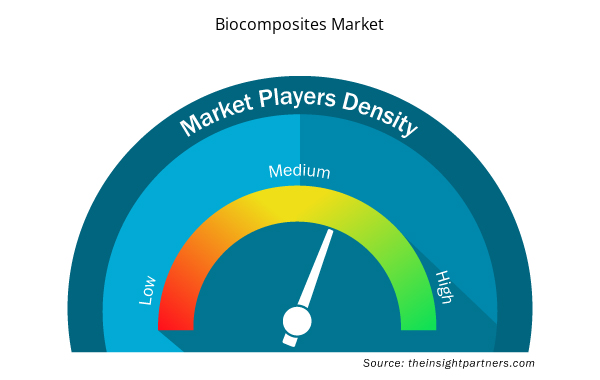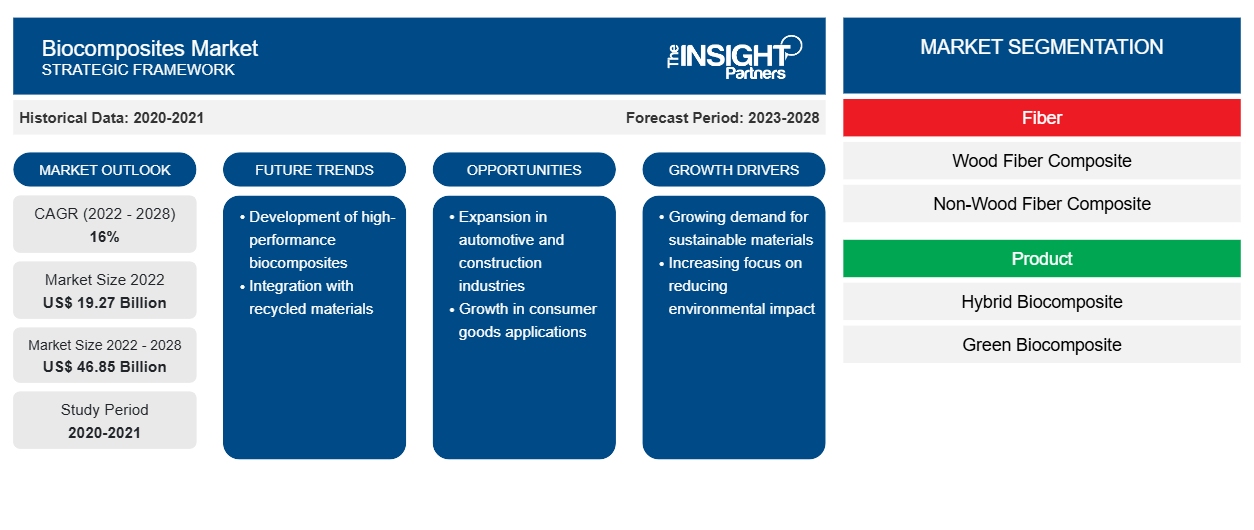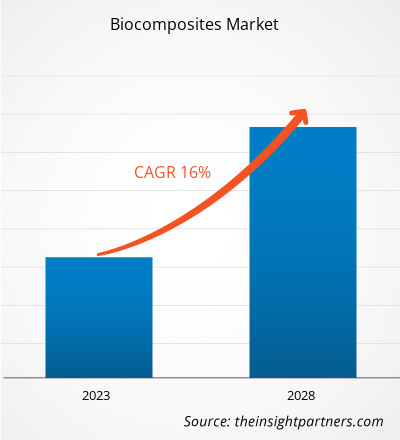[調査レポート] バイオ複合材料市場は、2022年の192億6,862万米ドルから2028年には468億5,139万米ドルに成長すると予想されており、 2022年から2028年にかけて16%のCAGRで成長すると予測されています。
市場分析
バイオ複合材料は、天然繊維とマトリックス(樹脂)の強化によって形成される材料です。バイオ複合材料は、入手の容易さ、高い比強度、軽量、生分解性、リサイクル性、低コスト、再生可能性など、多くの潜在的な利点があるため、基礎研究、包装、建設、軍事用途、航空宇宙、鉄道車両、自動車などの最終用途産業で急速に関心が高まっています。バイオ複合材料は、自動車業界で内装パネルの製造に広く使用されています。バイオ複合材料は環境に優しいため、さまざまな用途で高価なポリマー複合材料に取って代わりつつあります。
成長の原動力と課題
持続可能な建築材料の使用増加は、バイオ複合材料市場の成長を後押ししてきました。都市部の人口増加により、建設業界は急速な都市化の中で最も堅調な新興セクターの 1 つです。この都市化により、建設業界は材料の最も驚くべき消費者となり、そのほとんどは再生不可能な資源から作られています。世界建築建設同盟のレポートによると、建設部門は環境に最も有害な部門の 1 つです。調査によると、建設部門は環境に拡散する二酸化炭素排出量の 39%、世界のエネルギー消費量の 36%、原材料抽出の 50% を占めています。排出量は主に気候変動の原因であり、地球の温度を上昇させます。従来の建築材料は、資源とエネルギーを大量に消費します。そのため、社会と環境の両方に影響を与える従来の建築材料の危険性に対する懸念と認識が高まっています。これらの問題に対処するために、建設業界では新しい材料と技術が開発されています。バイオ複合材料は、再生不可能な廃棄物の排除、原材料の使用量削減、化石燃料の消費削減に役立つ持続可能な建築材料です。これらの材料は再生可能、リサイクル可能、生分解性の資源から作られており、構造および非構造建築要素として幅広い用途があるため、建設業界でのバイオ複合材料の使用に対する関心は世界的に高まっています。ただし、天然繊維複合材料には、繊維マトリックス界面の結合が悪い、濡れ性が悪い、吸水性が悪いなどの欠点がいくつかあります。これらの課題は、最終製品の強度と性能に影響します。バイオ複合材料の親水性は、周囲の環境から水を吸収する傾向があり、複合材料が膨張します。これらすべての要因が、予測期間中のバイオ複合材料市場の成長を妨げると予想されます。
要件に合わせてレポートをカスタマイズする
このレポートの一部、国レベルの分析、Excelデータパックなど、あらゆるレポートを無料でカスタマイズできます。また、スタートアップや大学向けのお得なオファーや割引もご利用いただけます。
- このレポートの主要な市場動向を入手してください。この無料サンプルには、市場動向から見積もりや予測に至るまでのデータ分析が含まれます。
レポートのセグメンテーションと範囲
「2028 年までの世界のバイオ複合材料市場分析」は、世界のバイオ複合材料市場の動向と成長機会に重点を置いた専門的で詳細な調査です。このレポートは、繊維、製品、最終用途、および地域別の詳細な市場区分とともに、世界のバイオ複合材料市場の概要を提供することを目的としています。世界のバイオ複合材料市場は、最近高い成長を遂げており、予測期間中もこの傾向が続くと予想されています。このレポートでは、世界のバイオ複合材料の消費量と、主要地域および国での需要に関する主要な統計を提供します。さらに、このレポートでは、主要地域および国でのバイオ複合材料市場のパフォーマンスに影響を与えるさまざまな要因の定性的な評価を提供します。このレポートには、バイオ複合材料市場の主要プレーヤーとその主要な戦略的展開に関する包括的な分析も含まれています。また、主要な推進要因、市場動向、および収益性の高いバイオ複合材料市場の機会を特定するために、市場ダイナミクスに関するいくつかの分析も含まれており、主要な収益源を特定するのに役立ちます。
さらに、エコシステム分析とポーターの 5 つの力の分析により、世界のバイオ複合材料市場の 360 度の視点が提供され、サプライ チェーン全体と市場の成長に影響を与えるさまざまな要因を理解するのに役立ちます。
セグメント分析
世界のバイオ複合材料市場は、繊維、製品、最終用途に基づいてセグメント化されています。繊維に基づいて、バイオ複合材料市場は木質繊維複合材料と非木質繊維複合材料に分かれています。製品に基づいて、市場はハイブリッドバイオ複合材料とグリーンバイオ複合材料に分類されます。最終用途に基づいて、市場は建築、自動車、消費財、その他に分類されています。
繊維ベースでは、木質繊維複合材セグメントがバイオコンポジット市場で大きなシェアを占めています。木質繊維複合材の主な欠点は湿気に弱いことですが、研究開発の増加に伴い、メーカーはより高い耐湿性、より高い剛性、より低い熱膨張係数を持つ木質繊維部品を生産しています。製品ベースでは、ハイブリッド複合材が最大の市場シェアでバイオコンポジット市場をリードしています。最終用途ベースでは、建築および建設セグメントがバイオコンポジット市場を支配しています。建物内のバイオコンポジットは、フレーム、壁と壁板、窓枠、ドア、床材、装飾パネル、キュービクルの壁、天井パネルに使用されます。一時的かつ調整可能な建築部品にバイオコンポジットを使用すると、構造内のインテリアデザインが変更された場合に埋め立て廃棄物が削減されます。
地域分析
このレポートは、北米、ヨーロッパ、アジア太平洋(APAC)、中東およびアフリカ(MEA)、中南米の5つの主要地域に関する世界のバイオ複合材料市場の詳細な概要を示しています。アジア太平洋地域は市場の大きなシェアを占めており、2022年には93億米ドル以上の価値があります。アジア太平洋地域には、中国、インド、日本、韓国、オーストラリアなど、いくつかの発展途上国と先進国が含まれています。その成長に貢献している重要な要因は、最終用途産業に対する建築・建設および輸送からの需要の増加です。バイオ複合材料の高い需要は、主に中国、日本、インド、韓国で見られます。また、輸送およびインフラ部門への外国直接投資(FDI)の増加は、今後数年間でバイオ複合材料の需要を牽引すると予想されます。ヨーロッパも、インフラ構築への政府支出の増加により、2028年に約110億米ドルと評価される大幅な成長が見込まれています。さらに、北米では、住宅・商業建築、消費財、自動車部門でバイオ複合材料が広く使用されています。これにより、バイオ複合材料市場に有利な機会が生まれています。北米のバイオ複合材料市場は、予測期間中に 15.0% の CAGR で成長すると予想されています。
業界の発展と将来の機会
パートナーシップ、買収、新製品の発売は、世界のバイオ複合材料市場で活動する企業が採用している主要な戦略であることがわかりました。
- アルケマは、2022年5月に、リサイクル可能でさらに効率の高い複合材料向けの新しいソリューションを発売する予定でした。
- 2021 年 3 月、Fiberon は、木材の比類のない美しさと温かさ、そして高性能でメンテナンスの手間が少ない素材の耐久性を兼ね備えたワイルドウッド複合クラッディングの発売を発表しました。
バイオコンポジット市場の地域別洞察
予測期間を通じてバイオ複合材料市場に影響を与える地域的な傾向と要因は、Insight Partners のアナリストによって徹底的に説明されています。このセクションでは、北米、ヨーロッパ、アジア太平洋、中東、アフリカ、南米、中米にわたるバイオ複合材料市場のセグメントと地理についても説明します。

- バイオコンポジット市場の地域別データを入手
バイオコンポジット市場レポートの範囲
| レポート属性 | 詳細 |
|---|---|
| 2022年の市場規模 | 192.7億米ドル |
| 2028年までの市場規模 | 468.5億米ドル |
| 世界のCAGR(2022年 - 2028年) | 16% |
| 履歴データ | 2020-2021 |
| 予測期間 | 2023-2028 |
| 対象セグメント | ファイバー別
|
| 対象地域と国 | 北米
|
| 市場リーダーと主要企業プロフィール |
|
市場プレーヤーの密度:ビジネスダイナミクスへの影響を理解する
バイオコンポジット市場は、消費者の嗜好の変化、技術の進歩、製品の利点に対する認識の高まりなどの要因により、エンドユーザーの需要が高まり、急速に成長しています。需要が高まるにつれて、企業は提供を拡大し、消費者のニーズを満たすために革新し、新たなトレンドを活用し、市場の成長をさらに促進しています。
市場プレーヤー密度とは、特定の市場または業界内で活動している企業または会社の分布を指します。これは、特定の市場スペースに、その規模または総市場価値と比較して、どれだけの競合相手 (市場プレーヤー) が存在するかを示します。
バイオ複合材料市場で事業を展開している主要企業は次のとおりです。
- 翻訳
- リングローブ
- ビーコンプ株式会社
- UPM
- フレックスフォームテクノロジーズ
免責事項:上記の企業は、特定の順序でランク付けされていません。

- バイオコンポジット市場のトップキープレーヤーの概要を入手
COVIDの影響/地政学的シナリオの影響/景気後退の影響
COVID-19パンデミックによるロックダウン、旅行制限、事業停止は、北米、ヨーロッパ、アジア太平洋(APAC)、中南米、中東アフリカ(MEA)のさまざまな国の経済と産業に悪影響を及ぼしました。この危機は、世界のサプライチェーン、製造活動、配送スケジュール、必須および非必須の製品の販売を混乱させました。さまざまな企業が、2020年に製品の配送が遅れる可能性や、製品の将来の販売が低迷する可能性があると発表しました。さらに、ヨーロッパ、アジア太平洋、北米のさまざまな政府によって課された国際旅行禁止により、いくつかの企業がコラボレーションとパートナーシップの計画を中止せざるを得ませんでした。これらすべての要因が2020年と2021年初頭に化学および材料業界を妨げ、バイオコンポジット市場を含むこの業界に関連するさまざまな市場の成長を抑制しました。
COVID-19の発生前、バイオコンポジット市場は主に自動車業界と建築・建設業界からの需要の高まりによって牽引されていました。しかし、2020年には、国境や国境の閉鎖によるバリューチェーンの混乱により、さまざまな業界が事業の減速を余儀なくされました。COVID-19のパンデミックは、各国の政府当局が課した制限により、主要な原材料のサプライチェーンを混乱させ、製造プロセスを混乱させました。しかし、経済は活動を回復しました。以前に延期されていた建設プロジェクトが再開され、バイオコンポジット市場のプレーヤーが正常に戻る機会がさらに提供されました。
競争環境と主要企業
バイオ複合材料市場で活動している主要企業としては、TTS、Lingrove、Bcomp Ltd、UPM、Flexform Technologies、Tecnaro GmbH、Fiberon、Arkema、Trex Company、Inc.、HempFlax Group BV などが挙げられます。
- 過去2年間の分析、基準年、CAGRによる予測(7年間)
- PEST分析とSWOT分析
- 市場規模価値/数量 - 世界、地域、国
- 業界と競争環境
- Excel データセット


- Artificial Intelligence in Healthcare Diagnosis Market
- Clinical Trial Supplies Market
- Photo Editing Software Market
- Clear Aligners Market
- Public Key Infrastructure Market
- Rugged Servers Market
- Architecture Software Market
- Ketogenic Diet Market
- Aesthetic Medical Devices Market
- Artificial Intelligence in Defense Market

Report Coverage
Revenue forecast, Company Analysis, Industry landscape, Growth factors, and Trends

Segment Covered
This text is related
to segments covered.

Regional Scope
North America, Europe, Asia Pacific, Middle East & Africa, South & Central America

Country Scope
This text is related
to country scope.
よくある質問
The green biocomposite is expected to be the fastest-growing segment during the forecast period. Green biocomposites are typically made by combining a biodegradable polymeric matrix with eco-friendly and renewable fibers. Increasing concern for the environment is driving the growth of green biocomposites during the forecast period.
During the forecast period, the automotive segment is expected to be the fastest-growing segment. Many automotive applications use biocomposites to achieve objectives, including light vehicle weight, fuel economy, low battery weight, low CO2 emissions, and high accident safety. Increasing demand for lightweight and fuel-efficient vehicles is propelling the demand for biocomposites during the forecast period.
The key driver fueling the biocomposites market's expansion is the population's increased awareness of the necessity for eco-friendly materials to protect the environment from degradation. Another aspect driving the biocomposites market's expansion is the growing use of biocomposites to lighten vehicles and increase safety. Other reasons that contributed to the market's growth include the introduction of strict government restrictions and safer usage of biocomposites than glass fiber.
In 2021, Asia-Pacific accounted for the largest share of the global biocomposites market. Due to growing environmental concerns, strict government restrictions, and a sense of social responsibility, the commercial and residential construction sector in the Asia Pacific is booming. Increased use of biocomposites in the building and construction sector led to the dominance of the Asia Pacific region in the global biocomposites market.
In 2021, the wood fiber composite segment held the largest market share. Composites made of wood fiber cost less than non-wood composites. These are used in a variety of applications, including residential, commercial, swimming pool, observation decks, and jetties. These are a few of the factors that led to the dominance of wood fiber composites in 2021.
The major players operating in the biocomposites market are TTS, Lingrove, Bcomp Ltd., UPM, Flexform Technologies, Tecnaro GMBH, Green Bay Decking, Fiberon LLC, Arkema, and Procotex.
Trends and growth analysis reports related to Chemicals and Materials : READ MORE..
The List of Companies - Biocomposites Market
- TTS
- Lingrove
- Bcomp Ltd
- UPM
- Flexform Technologies
- Tecnaro GMBH
- Green Bay Decking
- Fiberon LLC
- Arkema
- Procotex
The Insight Partners performs research in 4 major stages: Data Collection & Secondary Research, Primary Research, Data Analysis and Data Triangulation & Final Review.
- Data Collection and Secondary Research:
As a market research and consulting firm operating from a decade, we have published and advised several client across the globe. First step for any study will start with an assessment of currently available data and insights from existing reports. Further, historical and current market information is collected from Investor Presentations, Annual Reports, SEC Filings, etc., and other information related to company’s performance and market positioning are gathered from Paid Databases (Factiva, Hoovers, and Reuters) and various other publications available in public domain.
Several associations trade associates, technical forums, institutes, societies and organization are accessed to gain technical as well as market related insights through their publications such as research papers, blogs and press releases related to the studies are referred to get cues about the market. Further, white papers, journals, magazines, and other news articles published in last 3 years are scrutinized and analyzed to understand the current market trends.
- Primary Research:
The primarily interview analysis comprise of data obtained from industry participants interview and answers to survey questions gathered by in-house primary team.
For primary research, interviews are conducted with industry experts/CEOs/Marketing Managers/VPs/Subject Matter Experts from both demand and supply side to get a 360-degree view of the market. The primary team conducts several interviews based on the complexity of the markets to understand the various market trends and dynamics which makes research more credible and precise.
A typical research interview fulfils the following functions:
- Provides first-hand information on the market size, market trends, growth trends, competitive landscape, and outlook
- Validates and strengthens in-house secondary research findings
- Develops the analysis team’s expertise and market understanding
Primary research involves email interactions and telephone interviews for each market, category, segment, and sub-segment across geographies. The participants who typically take part in such a process include, but are not limited to:
- Industry participants: VPs, business development managers, market intelligence managers and national sales managers
- Outside experts: Valuation experts, research analysts and key opinion leaders specializing in the electronics and semiconductor industry.
Below is the breakup of our primary respondents by company, designation, and region:

Once we receive the confirmation from primary research sources or primary respondents, we finalize the base year market estimation and forecast the data as per the macroeconomic and microeconomic factors assessed during data collection.
- Data Analysis:
Once data is validated through both secondary as well as primary respondents, we finalize the market estimations by hypothesis formulation and factor analysis at regional and country level.
- Macro-Economic Factor Analysis:
We analyse macroeconomic indicators such the gross domestic product (GDP), increase in the demand for goods and services across industries, technological advancement, regional economic growth, governmental policies, the influence of COVID-19, PEST analysis, and other aspects. This analysis aids in setting benchmarks for various nations/regions and approximating market splits. Additionally, the general trend of the aforementioned components aid in determining the market's development possibilities.
- Country Level Data:
Various factors that are especially aligned to the country are taken into account to determine the market size for a certain area and country, including the presence of vendors, such as headquarters and offices, the country's GDP, demand patterns, and industry growth. To comprehend the market dynamics for the nation, a number of growth variables, inhibitors, application areas, and current market trends are researched. The aforementioned elements aid in determining the country's overall market's growth potential.
- Company Profile:
The “Table of Contents” is formulated by listing and analyzing more than 25 - 30 companies operating in the market ecosystem across geographies. However, we profile only 10 companies as a standard practice in our syndicate reports. These 10 companies comprise leading, emerging, and regional players. Nonetheless, our analysis is not restricted to the 10 listed companies, we also analyze other companies present in the market to develop a holistic view and understand the prevailing trends. The “Company Profiles” section in the report covers key facts, business description, products & services, financial information, SWOT analysis, and key developments. The financial information presented is extracted from the annual reports and official documents of the publicly listed companies. Upon collecting the information for the sections of respective companies, we verify them via various primary sources and then compile the data in respective company profiles. The company level information helps us in deriving the base number as well as in forecasting the market size.
- Developing Base Number:
Aggregation of sales statistics (2020-2022) and macro-economic factor, and other secondary and primary research insights are utilized to arrive at base number and related market shares for 2022. The data gaps are identified in this step and relevant market data is analyzed, collected from paid primary interviews or databases. On finalizing the base year market size, forecasts are developed on the basis of macro-economic, industry and market growth factors and company level analysis.
- Data Triangulation and Final Review:
The market findings and base year market size calculations are validated from supply as well as demand side. Demand side validations are based on macro-economic factor analysis and benchmarks for respective regions and countries. In case of supply side validations, revenues of major companies are estimated (in case not available) based on industry benchmark, approximate number of employees, product portfolio, and primary interviews revenues are gathered. Further revenue from target product/service segment is assessed to avoid overshooting of market statistics. In case of heavy deviations between supply and demand side values, all thes steps are repeated to achieve synchronization.
We follow an iterative model, wherein we share our research findings with Subject Matter Experts (SME’s) and Key Opinion Leaders (KOLs) until consensus view of the market is not formulated – this model negates any drastic deviation in the opinions of experts. Only validated and universally acceptable research findings are quoted in our reports.
We have important check points that we use to validate our research findings – which we call – data triangulation, where we validate the information, we generate from secondary sources with primary interviews and then we re-validate with our internal data bases and Subject matter experts. This comprehensive model enables us to deliver high quality, reliable data in shortest possible time.


 このレポートの無料サンプルを入手する
このレポートの無料サンプルを入手する